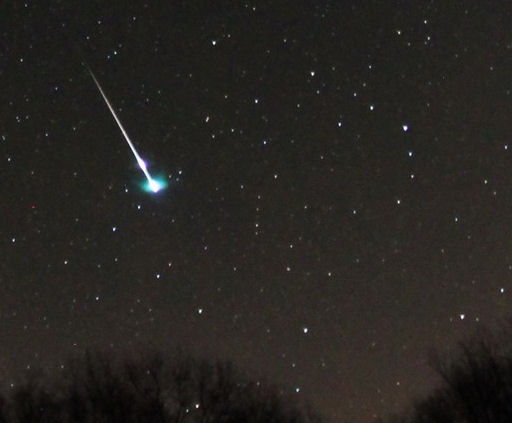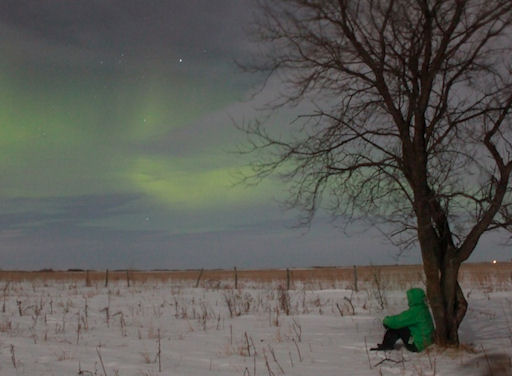MERCURY-DIRECTED CME: A coronal mass ejection (CME) that blasted away from the farside of the sun yesterday is heading for Mercury. According to analysts at the Goddard Space Weather Lab, it should hit the innermost planet on Jan. 3rd around 16:30 UT. [forecast track]
QUADRANTID METEOR SHOWER: Earth is about to pass through a stream of debris from 2003 EH1, a comet fragment that produces the annual Quadrantid meteor shower. Forecasters expect the shower to peak around 07:20 UT (02:20 am EST) on Wednesday morning, January 4th. At maximum, as many as 100 meteors/hour could emerge from a radiant near Polaris, the north star.
Brian Emfinger of Ozark, Arkansas, photographed this one on Jan. 2nd:
"
Wow! What a really nice fireball," says Emfinger. "It emerged very very close to the Quadrantid radiant, but I'm not 100% sure it is indeed an early Quadrantid."
One thing's for sure: It's a good reason to wake up early on Wednesday morning. Stay tuned for Quads! [more]
FIRST AURORAS OF 2012: The first auroras of the New Year appeared over Canada last night. "I was out with some friends when we looked up to see the Northern Lights suddenly blazing away over our heads," reports photographer Jesse Thompson of Inglis, Manitoba. Here is a self-portrait of Thompson enjoying the show:
The display was caused by the interplanetary magnetic field (IMF), which tipped south on Jan. 2nd and partially canceled Earth's own north-pointing magnetic field. A crack formed in Earth's magnetosphere, allowing solar wind to flow in and fuel the auroras. Aurora alerts: text, voice.

Solar wind
speed: 407.3 km/sec
density: 3.3 protons/cm3
explanation | more data
Updated: Today at 1314 UT
X-ray Solar Flares
6-hr max: B7 1006 UT Jan03
24-hr: B9 0154 UT Jan03
explanation | more data
Updated: Today at: 1300 UT
![]()
Daily Sun: 03 Jan 12
Sunspot 1389 is in decay and poses a declining threat for M-class solar flares. Credit: SDO/HMI
![]()
Sunspot number: 83
What is the sunspot number?
Updated 02 Jan 2012
Spotless Days
Current Stretch: 0 days
2012 total: 0 days (0%)
2011 total: 2 days (<1%)
2010 total: 51 days (14%)
2009 total: 260 days (71%)
Since 2004: 821 days
Typical Solar Min: 486 days
Updated 02 Jan 2012
The Radio Sun
10.7 cm flux: 135 sfu
explanation | more data
Updated 02 Jan 2012
![]()
Current Auroral Oval:
Switch to: Europe, USA, New Zealand, Antarctica
Credit: NOAA/POES
![]()
Planetary K-index
Now: Kp= 1 quiet
24-hr max: Kp= 3 quiet
explanation | more data
Interplanetary Mag. Field
Btotal: 5.8 nT
Bz: 3 nT south
explanation | more data
Updated: Today at 1306 UT
![]()
Coronal Holes: 03 Jan 12
Solar wind flowing from this coronal hole is gently buffeting Earth's magnetic field. Credit: SDO/AIA.





